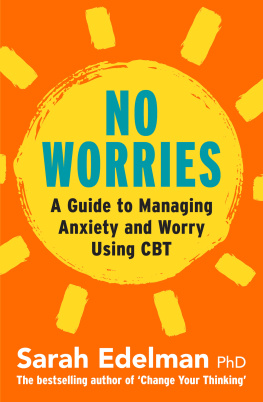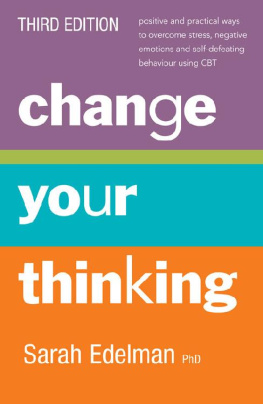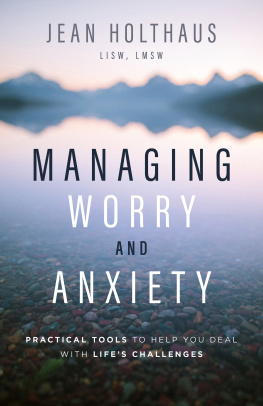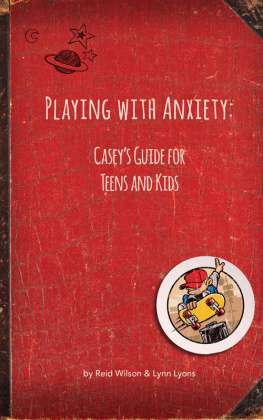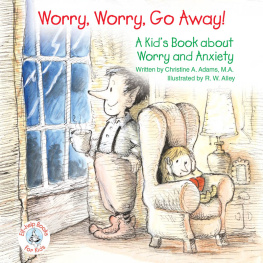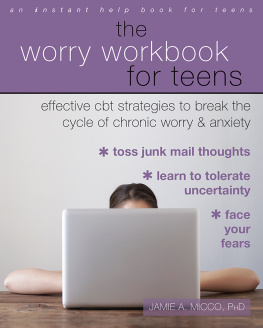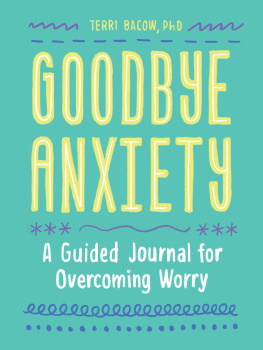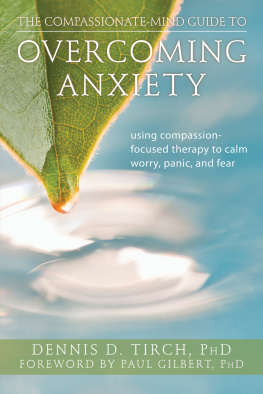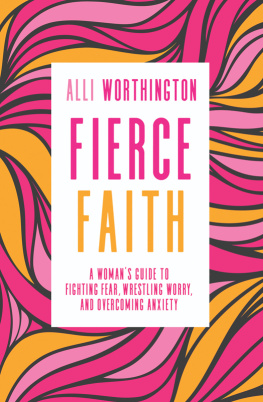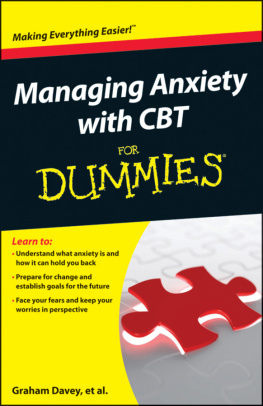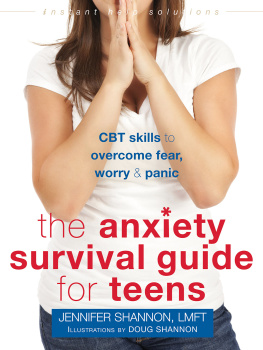Sarah Edelman - No Worries: A Guide to Releasing Anxiety and Worry Using CBT
Here you can read online Sarah Edelman - No Worries: A Guide to Releasing Anxiety and Worry Using CBT full text of the book (entire story) in english for free. Download pdf and epub, get meaning, cover and reviews about this ebook. year: 2019, publisher: ABC Books, genre: Home and family. Description of the work, (preface) as well as reviews are available. Best literature library LitArk.com created for fans of good reading and offers a wide selection of genres:
Romance novel
Science fiction
Adventure
Detective
Science
History
Home and family
Prose
Art
Politics
Computer
Non-fiction
Religion
Business
Children
Humor
Choose a favorite category and find really read worthwhile books. Enjoy immersion in the world of imagination, feel the emotions of the characters or learn something new for yourself, make an fascinating discovery.
- Book:No Worries: A Guide to Releasing Anxiety and Worry Using CBT
- Author:
- Publisher:ABC Books
- Genre:
- Year:2019
- Rating:3 / 5
- Favourites:Add to favourites
- Your mark:
- 60
- 1
- 2
- 3
- 4
- 5
No Worries: A Guide to Releasing Anxiety and Worry Using CBT: summary, description and annotation
We offer to read an annotation, description, summary or preface (depends on what the author of the book "No Worries: A Guide to Releasing Anxiety and Worry Using CBT" wrote himself). If you haven't found the necessary information about the book — write in the comments, we will try to find it.
Sarah Edelman: author's other books
Who wrote No Worries: A Guide to Releasing Anxiety and Worry Using CBT? Find out the surname, the name of the author of the book and a list of all author's works by series.
No Worries: A Guide to Releasing Anxiety and Worry Using CBT — read online for free the complete book (whole text) full work
Below is the text of the book, divided by pages. System saving the place of the last page read, allows you to conveniently read the book "No Worries: A Guide to Releasing Anxiety and Worry Using CBT" online for free, without having to search again every time where you left off. Put a bookmark, and you can go to the page where you finished reading at any time.
Font size:
Interval:
Bookmark:
Contents
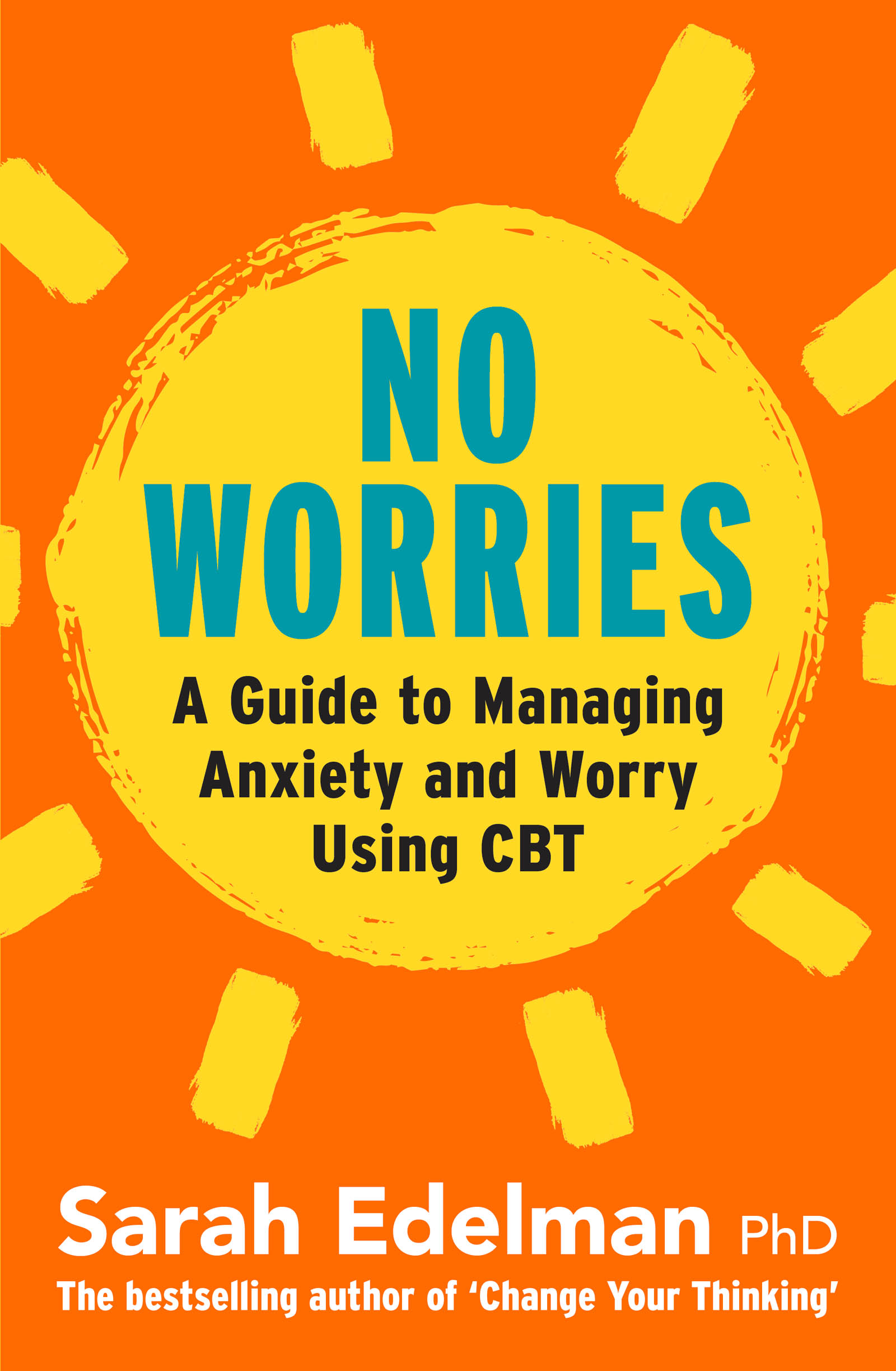
DR SARAH EDELMAN is a clinical psychologist, author and trainer. She previously worked as a researcher and lecturer at the University of Technology Sydney. In addition to her clinical work Sarah conducts training programs for mental health professionals and business organisations, and runs workshops on Changing Your Thinking at Sydney University Centre for Continuing Education. She has published articles in professional and mainstream journals, and is a regular guest on ABC radio. Her book, Change your Thinking, is a best seller in the self-help genre. She is also co-author of Good Thinking: A teenagers guide to managing stress and emotions using CBT.

 | The ABC Wave device is a trademark of the Australian Broadcasting Corporation and is used under licence by HarperCollinsPublishers Australia. |
First published in Australia in 2019
by HarperCollinsPublishers Australia Pty Limited
ABN 36 009 913 517
harpercollins.com.au
Copyright Sarah Edelman 2019
The right of Sarah Edelman to be identified as the author of this work has been asserted by her in accordance with the Copyright Amendment (Moral Rights) Act 2000.
This work is copyright. Apart from any use as permitted under the Copyright Act 1968, no part may be reproduced, copied, scanned, stored in a retrieval system, recorded, or transmitted, in any form or by any means, without the prior written permission of the publisher.
HarperCollinsPublishers
Level 13, 201 Elizabeth Street, Sydney, NSW 2000, Australia
Unit D1, 63 Apollo Drive, Rosedale 0632, Auckland, New Zealand
A 75, Sector 57, Noida, Uttar Pradesh 201 301, India
1 London Bridge Street, London SE1 9GF, United Kingdom
Bay Adelaide Centre, East Tower, 22 Adelaide Street West, 41st Floor, Toronto, Ontario, M5H 4E3, Canada
195 Broadway, New York, NY 10007, USA
ISBN: 978 0 7333 3977 6 (paperback)
ISBN: 978 1 4607 1093 7 (ebook)
A catalogue record for this book is available from the National Library of Australia
Cover design by Gemma Banks, HarperCollins Design Studio
Contents
No regrets, just lessons.
No worries, just acceptance.
No expectations, just gratitude.
Life is too short.
UNKNOWN SOURCE
Some peoples lives are easy. Not because they are particularly privileged or clever, but because they have been blessed with a calm, easygoing nature. Like everyone, they experience difficulties, demands and pressures in their lives, but they are able to face them without unnecessary anguish. When problems arise they look for solutions, and in circumstances where there is nothing they can do, they adapt. They are able to do this because they have a relaxed disposition and a flexible thinking style that enables them to adjust to stressful situations, without the additional burden of worry, rumination and overthinking. So, they rarely experience the distressing thoughts and intense bodily sensations that accompany high levels of anxiety.
To have such a disposition is a gift. In the card game of life, they have been dealt a good hand.
Many of us are not so fortunate. A combination of nature and nurture have conspired to make us prone to anxiety, making our world feel unsafe. We may be overly focused on a myriad bad things that could happen to us or our loved ones, or we may zero in on specific threats, such as failure, disapproval, humiliation or not fitting in. We may be particularly anxious about unwanted thoughts that pop into our minds, or unwanted body sensations that signal the possibility of panic. We may be excessively apprehensive about potential illness and death, or we may fear being in places from which escape would be difficult, such as tunnels, lifts and freeways.
While the objects of our angst vary, the underlying problem is the same. Our mind keeps directing us to be alert to danger, and our body is prepared for action. Anxiety affects the way we feel and behave, and deprives us of the ability to relax and enjoy life.
Anxiety disorders affect approximately 14 per cent of Australians each year, and over 20 per cent at some stage in their lives. Thats over three million people annually, and over five million people over the course of their lifetime. It is also not uncommon for people to have a combination of anxiety disorders, sometimes with occasional periods of depression. Anxiety disorders are the most common mental-health problem experienced by both males and females, though women are affected more frequently than men (18 per cent versus 11 per cent).
Some people are particularly prone to worry. Although our life circumstances may be quite agreeable, we feel unsafe. So, we might find ourselves planning solutions to non-existent problems, or overthinking situations that dont warrant analysis. At work or at play, with friends or with children, on holidays or at home, worry prevents us from being present. It impairs our ability to engage with what is happening right now. It robs us of joy and occupies too much of our mental space. It wastes energy and distracts us. Yet it can be such a habitual part of our thinking that it feels perfectly normal, and we may even assume that everyone thinks this way.
Anxiety is a big subject, and its various manifestations have been described in detail in many books. In No Worries, we will explore habits of thinking and behaviour that are common to many anxiety disorders. Understanding the way that anxiety operates how it affects our brains, minds, bodies and behaviour provides insight, and a rationale for strategies that can help us to recover. Working through the exercises in this book will increase understanding of your own anxiety, including the things you unwittingly do that perpetuate it.
In addition to exploring anxiety more broadly, we will focus specifically on worry, and the anxiety disorder characterised by excessive worrying: generalised anxiety disorder (GAD). Some researchers have described GAD as the prototype anxiety disorder, as many of its features are observable in all anxiety disorders. These include unrealistic assessment of threat, hypervigilance, physical arousal, muscle tension and other physical symptoms, reasoning errors, use of avoidance and safety behaviours, insomnia, restlessness, concentration difficulties and fatigue. Worry and intolerance of uncertainty are common manifestations of most anxiety disorders. Interestingly, successful therapy for GAD often results in reduced symptoms in coexisting anxiety disorders, including social anxiety, illness anxiety, panic disorder and phobias. So responding to the processes that give rise to and perpetuate anxiety and worry is likely to be helpful not just for resolving GAD, but for managing anxiety more broadly.
Individuals who are prone to anxiety also have greater likelihood of experiencing panic attacks. In some cases, repeated panic attacks can lead to panic disorder, which is characterised and reinforced by fear of further panic attacks. Panic disorder sometimes co-occurs with GAD, as well as with other anxiety disorders, and can be the source of much distress. Fortunately, it is a disorder that lends itself well to psychoeducation and self-help strategies. Understanding the nature of panic, what perpetuates it and how it can be relieved can lead to a significant reduction in symptoms. For this reason, I have included a chapter on this topic towards the end of the book.
Next pageFont size:
Interval:
Bookmark:
Similar books «No Worries: A Guide to Releasing Anxiety and Worry Using CBT»
Look at similar books to No Worries: A Guide to Releasing Anxiety and Worry Using CBT. We have selected literature similar in name and meaning in the hope of providing readers with more options to find new, interesting, not yet read works.
Discussion, reviews of the book No Worries: A Guide to Releasing Anxiety and Worry Using CBT and just readers' own opinions. Leave your comments, write what you think about the work, its meaning or the main characters. Specify what exactly you liked and what you didn't like, and why you think so.

